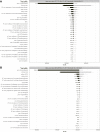Atezolizumab plus platinum-based chemotherapy as first-line therapy for metastatic urothelial cancer: A cost-effectiveness analysis
- PMID: 36071854
- PMCID: PMC9441572
- DOI: 10.3389/fphar.2022.872196
Atezolizumab plus platinum-based chemotherapy as first-line therapy for metastatic urothelial cancer: A cost-effectiveness analysis
Abstract
Purpose: According to the IMvigor130 trial, adding atezolizumab to platinum-based chemotherapy was effective in the treatment of metastatic urothelial cancer (mUC). Based on the perspective of the United States and China, the current study evaluated cost-effectiveness of atezolizumab plus chemotherapy for mUC patients in the first-line setting. Methods: A partitioned survival model was adopted for mUC patients. The survival data were derived from the IMvigor130 trial. Direct cost values were collected from the Centers for Medicare and Medicaid Services (CMS), Chinese Drug Bidding Database, and published literatures. The utility and toxicity data were gathered from related research studies and IMvigor130 trial. The incremental cost-utility ratios (ICURs) and incremental cost-effectiveness ratios (ICERs) were calculated and analyzed. Scenario analyses and sensitivity analyses were performed to observe the outputs and uncertainties. Results: The base-case analysis showed that the ICUR of atezolizumab plus chemotherapy versus chemotherapy in American and Chinese settings is $ 737,371 /QALY and $ 385,384 /QALY, respectively. One-way sensitivity analyses showed that the ICUR ranged from $ 555,372/QALY to $ 828,205/QALY for the United States. Also, the range was from $ 303,099/QALY to $ 433,849/QALY in the Chinese setting. A probabilistic sensitivity analysis showed the likelihood that atezolizumab plus chemotherapy becoming the preferred strategy was a little low even if the price reduction strategy was applied. Conclusion: Adding atezolizumab to chemotherapy improved survival time, but it is not a cost-saving option compared to chemotherapy for metastatic urothelial cancer patients in the American and Chinese settings.
Keywords: atezolizumab; cost-effectiveness; metastatic urothelial cancer; partitioned survival model; the perspective of the United States and China.
Copyright © 2022 Liu, Lang, Chai, Lin, Liao and Zhu.
Conflict of interest statement
The authors declare that the research was conducted in the absence of any commercial or financial relationships that could be construed as a potential conflict of interest.
Figures




Similar articles
-
Cost-Effectiveness of Atezolizumab Plus Chemotherapy as First-Line Therapy for Metastatic Urothelial Cancer.Adv Ther. 2021 Jun;38(6):3399-3408. doi: 10.1007/s12325-021-01785-9. Epub 2021 May 21. Adv Ther. 2021. PMID: 34019245
-
Atezolizumab with chemotherapy in first-line treatment for metastatic urothelial cancer: a cost-effectiveness analysis.J Comp Eff Res. 2022 Oct;11(14):1021-1030. doi: 10.2217/cer-2022-0064. Epub 2022 Aug 4. J Comp Eff Res. 2022. PMID: 35924662
-
Cost-Effectiveness Analysis of Atezolizumab Versus Chemotherapy as First-Line Treatment for Metastatic Non-Small-Cell Lung Cancer With Different PD-L1 Expression Status.Front Oncol. 2021 Apr 27;11:669195. doi: 10.3389/fonc.2021.669195. eCollection 2021. Front Oncol. 2021. PMID: 33987103 Free PMC article.
-
Paclitaxel: a pharmacoeconomic review of its use in the treatment of ovarian cancer.Pharmacoeconomics. 2001;19(12):1227-59. doi: 10.2165/00019053-200119120-00005. Pharmacoeconomics. 2001. PMID: 11772158 Review.
-
Economic Evaluation of Bevacizumab for the First-Line Treatment of Newly Diagnosed Glioblastoma Multiforme.J Clin Oncol. 2015 Jul 10;33(20):2296-302. doi: 10.1200/JCO.2014.59.7245. Epub 2015 May 26. J Clin Oncol. 2015. PMID: 26014296 Review.
Cited by
-
Enfortumab vedotin plus pembrolizumab as a first-line treatment for advanced urothelial carcinoma: a cost-effectiveness analysis from China based on the EV-302 trial.Front Pharmacol. 2024 Sep 26;15:1412292. doi: 10.3389/fphar.2024.1412292. eCollection 2024. Front Pharmacol. 2024. PMID: 39391700 Free PMC article.
-
Economic evaluation of Erdafitinib as a second-line treatment for advanced metastatic urothelial carcinoma: real-world data from the USA and prospective analysis from China.Future Oncol. 2025 Jun;21(15):1919-1927. doi: 10.1080/14796694.2025.2504321. Epub 2025 May 10. Future Oncol. 2025. PMID: 40346959
-
Adverse Event Costs and Cost-Effectiveness Analyses of Anticancer Drugs: A Systematic Review.JAMA Netw Open. 2025 May 1;8(5):e2512455. doi: 10.1001/jamanetworkopen.2025.12455. JAMA Netw Open. 2025. PMID: 40423968 Free PMC article.
-
Cost-effectiveness of first-line enfortumab vedotin in addition to pembrolizumab for metastatic urothelial carcinoma in the United States.Front Immunol. 2024 Sep 9;15:1464092. doi: 10.3389/fimmu.2024.1464092. eCollection 2024. Front Immunol. 2024. PMID: 39315111 Free PMC article.
References
-
- Agency for Healthcare Research and Quality (2022). Healthcare cost and utilization project. Available at: https://hcupnet.ahrq.gov/#setup (Accessed January 15, 2022). - PubMed
-
- Aly A., Johnson C., Yang S., Botteman M. F., Rao S., Hussain A. (2019). Overall survival, costs, and healthcare resource use by line of therapy in Medicare patients with newly diagnosed metastatic urothelial carcinoma. J. Med. Econ. 22 (7), 662–670. 10.1080/13696998.2019.1591424 - DOI - PMC - PubMed
LinkOut - more resources
Full Text Sources

